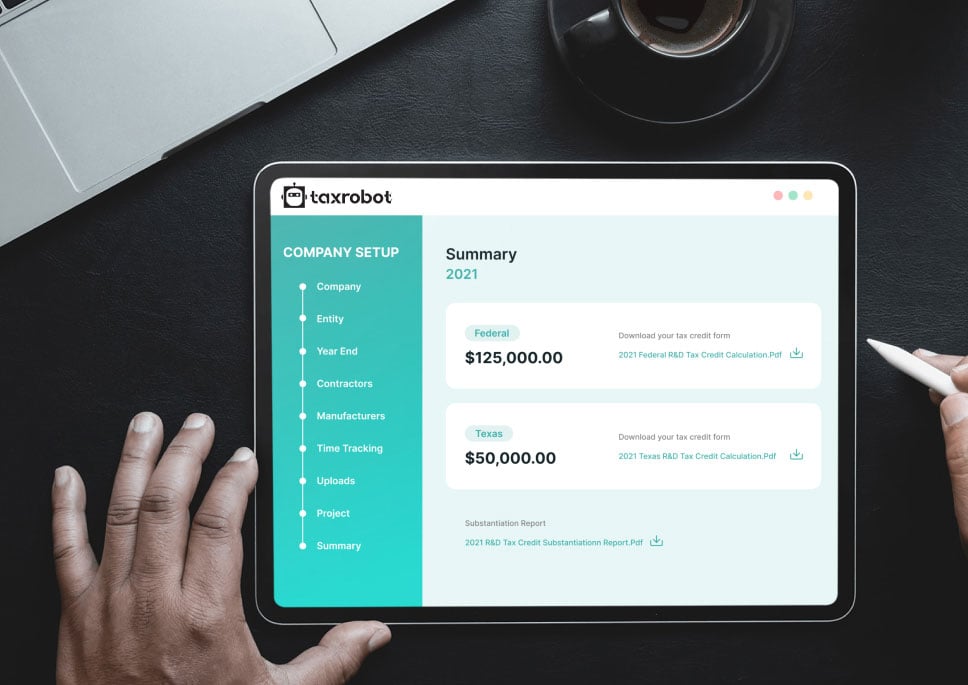South Carolina R&D Tax Credit
Discover the future of Research and Development (R&D) tax credits with TaxRobot. Our advanced AI-powered software is designed to revolutionize your R&D tax credit claim process, making it more efficient, precise, and beneficial for businesses across South Carolina.
Maximize your State Credits today!
Put the R&D tax credit process on autopilot.
Trusted By:








South Carolina R&D Tax Credits
Discover your eligibility for South Carolina R&D tax credits and supercharge your enterprise.
Transform Your R&D Tax Credit Process with TaxRobot
TaxRobot leverages innovative artificial intelligence technology to navigate the intricate maze of R&D tax credits. By integrating with your existing accounting and payroll systems, our software identifies qualifying activities and expenditures in line with current IRS guidelines. This comprehensive approach ensures that you can claim your credits with confidence and maximize your return.
Why is the R&D Tax Credit Important to South Carolina Businesses?
The R&D tax credit is an all-important government incentive encouraging innovation within the United States. For businesses in South Carolina, these credits can drastically reduce your tax liability and improve your cash flow. As we continue to see growth in sectors such as software development, robotics, and technology, the potential for claiming R&D tax credits has never been greater.
How Can TaxRobot Help South Carolina Businesses?
Our software is specially designed to make the process of claiming R&D tax credits as simple and efficient as possible. Here’s how:
- Automated Identification: Our AI technology sifts through your data to identify qualifying activities and expenses accurately.
- Precise Calculations: TaxRobot calculates your potential R&D tax credit, providing a detailed report ready for submission to the IRS.
- Audit-Proof Documentation: We help you compile and organize necessary documentation, ensuring you’re prepared for any potential audit.
Keeping Up with the Evolving Landscape in South Carolina
South Carolina is at the forefront of technological innovation, with partnerships like the one between Winthrop University and robotics software firm UiPath highlighting the state’s commitment to embracing modern technology.
With these advancements, the opportunity to claim R&D tax credits has expanded. TaxRobot’s software is constantly updated to keep pace with these changes, ensuring businesses in South Carolina can maximize their R&D tax credits.
Get Started with TaxRobot Today
Don’t navigate the complexities of R&D tax credits alone. Let TaxRobot be your partner in this journey. Our team of seasoned tax professionals is also on hand to provide personalized assistance, ensuring you get the most out of your R&D tax credits.
Start revolutionizing your R&D tax credits process today. Contact us here at TaxRobot and let our AI-powered software do the heavy lifting for you.
Frequently Asked Questions
Do you have to reduce expenses for R&D credit?
According to I.R.C. §280C, taxpayers must dial down the research expenditure deduction otherwise allowed by the amount of the research credit claimed. It’s like a balancing act for your tax deductions! TaxRobot can help you determine the precise amount of your R&D tax credits to maximize your savings.
Does South Carolina have a research and development credit?
Yes! South Carolina has both federal and state R&D credits, allowing businesses to take advantage of significant tax savings. With TaxRobot’s software, it’s easier than ever to calculate precisely how much credit you qualify for.
Can TaxRobot help with other state R&D credits?
Yes! Our software can help with R&D tax credit opportunities in numerous other states, including California, New Jersey, Ohio, and Virginia. We’re constantly updating our system to ensure we can provide the most up-to-date information on all available R&D credits.
What happens to unused R&D credits?
Did you know that eligible businesses can still unlock untapped R&D tax credits? By simply filing amended tax returns for the overlooked years, these credits can be claimed! And the best part? Once claimed, businesses can carry forward these unused credits for up to 20 years. Talk about a win-win situation.
Take a sneak peak

- Limited Time Offer
- Simple Onboarding
- Easy to Use
R&D Tax Credits FAQs
The four-part test as outlined in the Internal Revenue Code is used to determine qualified R&D activity.
The Four-Part Test
1). New Or Improved Business Component
Creation of a new product, process, formula, invention, software, or technique; or improving the performance, functionality, quality, or reliability of existing business component.
- Construction of new buildings or renovation of existing buildings
- Invention of a software application
- Manufacturing of a new product or the improvement of the production process for an existing product
- Creation of design documentation
2). Technological In Nature
The activity fundamentally relies on principles of the physical or biological sciences, engineering, or computer science. A taxpayer does not need to obtain information that exceeds, expands or refines the common knowledge of skilled professionals in a particular field.
- Physics (relationship between mass, density and volume; loading as the
result of gravitational attraction) - Engineering (mechanical, electrical, civil, chemical)
- Computer science (theory of computation and design of computational systems)
3). Elimination Of Uncertainty
Uncertainty exists if the information available to the taxpayer does not establish the capability or method for developing or improving the business component, or the appropriate design of the business component.
- The capability of a manufacturer to create a part within the specified tolerances
- The appropriate method of overcoming unsuitable soil conditions during construction
- The appropriate software design to meet quality and volatility requirements
4). Process Of Experimentation
A process designed to evaluate one or more alternatives to achieve a result where the capability or method of achieving that result, or the appropriate design of that result, is uncertain as of the beginning of the taxpayer’s research activities.
- Systematic process of trial and error
- Evaluating alternative means and methods
- Computer modeling or simulation Prototyping Testing
The R&D tax credit is one of the most misunderstood tax incentives available. Considering the myriad of industries and activities that legally qualify for the credit, the term “research and development” is a misnomer. Additionally, the R&D tax credit requires specialized knowledge and technology to identify and calculate the incentive properly.
Companies of various industries are unaware that they are eligible to claim the R&D tax credit. Under the Internal Revenue Code’s definition of R&D, many common activities qualify. You can get tax benefits for industries including software, technology, architecture, engineering, construction, manufacturing, and more.
The R&D tax credit can be claimed for all open tax years. Generally, open tax years include the prior three tax years due to the statute of limitations period. In certain circumstances, the law allows businesses to claim the R&D tax credit for an extended period of time. It is common for companies to amend previous tax years to claim this benefit and reduce the maximum amount of tax liability.
Partnerships and S corporations must file this form to claim the credit. The credit will flow from the Form 6765, to the Schedule K-1, to the Form 3800 on the individual’s tax return. For individuals receiving this credit that have ownership interest in a partnership or S corporation, Form 6765 is not required on the individual return.
Individuals claiming this credit can report the credit directly on Form 3800, General Business Credit if their only source for the credit is a partnership, S corporation, estate, or trust. Otherwise, Form 6765 must be filed with the individual’s tax return (e.g. sole proprietorship).
For tax years prior to 2016, the credit can be used to reduce the taxpayer’s regular tax liability down to the tentative minimum tax. The credit cannot be used to offset alternative minimum tax. Beginning in tax year 2016, eligible small businesses have expanded utilization for the credit. For these eligible small businesses, the regular tax liability can offset alternative minimum tax using the “25/25” rule.
What our customers have to say
I highly recommend TaxRobot to anyone considering an R&D Tax Credit software to complete their analysis.

We decided to switch to TaxRobot… Best decision we’ve ever made. More affordable, and less complicated.

I couldn’t believe how easy it was! In under an hour, we saved enough money to hire a new employee.
